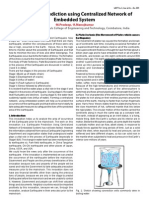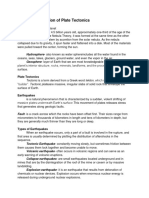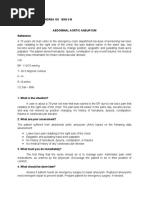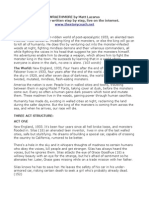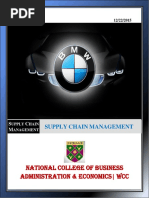Plate Tectonics Plate Tectonics: Crust Mantle Plate Boundaries Thrust Faults Oceanic Spreading Ridges Transform Faults
Plate Tectonics Plate Tectonics: Crust Mantle Plate Boundaries Thrust Faults Oceanic Spreading Ridges Transform Faults
Uploaded by
Faye Andrea FranciscoCopyright:
Available Formats
Plate Tectonics Plate Tectonics: Crust Mantle Plate Boundaries Thrust Faults Oceanic Spreading Ridges Transform Faults
Plate Tectonics Plate Tectonics: Crust Mantle Plate Boundaries Thrust Faults Oceanic Spreading Ridges Transform Faults
Uploaded by
Faye Andrea FranciscoOriginal Title
Copyright
Available Formats
Share this document
Did you find this document useful?
Is this content inappropriate?
Copyright:
Available Formats
Plate Tectonics Plate Tectonics: Crust Mantle Plate Boundaries Thrust Faults Oceanic Spreading Ridges Transform Faults
Plate Tectonics Plate Tectonics: Crust Mantle Plate Boundaries Thrust Faults Oceanic Spreading Ridges Transform Faults
Uploaded by
Faye Andrea FranciscoCopyright:
Available Formats
Plate Tectonics
plate tectonics
Plate Tectonics is the theory supported by a wide range of evidence that considers
the earth's crust and upper mantle to be composed of several large, thin, relatively rigid
plates that move relative to one another. Slip on faults that define the plate
boundaries commonly results in earthquakes. Several styles of faults bound the plates,
including thrust faults along which plate material is subducted or consumed in the
mantle, oceanic spreading ridges along which new crustal material is produced,
and transform faults that accommodate horizontal slip (strike slip) between adjoining
plates.
Mantle convection currents, ridge push and slab pull are three of the forces that have
been proposed as the main drivers of plate movement
There are a number of competing theories that attempt to explain what drives the
movement of tectonic plates. Three of the forces that have been proposed as the main
drivers of tectonic plate movement are:
-mantle convection currents— warm mantle currents drive and carry plates of
lithosphere along a like a conveyor belt;
-ridge push (buoyant upwelling mantle at mid-ocean ridges) — newly-formed
plates at oceanic ridges are warm, and so have a higher elevation at the oceanic
ridge than the colder, more dense plate material further away; gravity causes the
higher plate at the ridge to push away the lithosphere that lies further from the
ridge;
-slab pull — older, colder plates sink at subduction zones, because as they cool,
they become more dense than the underlying mantle. The cooler sinking plate
pulls the rest of the warmer plate along behind it.
Recent research has shown that the major driving force for most plate movement is
slab pull, because the plates with more of their edges being subducted are the faster-
moving ones. However ridge push is also presented in recent research to be a force
that drives the movement of plates.
What is Convection Current
A convection current is a process which involves the movement of energy from
one place to another. Convection currents tend to move a fluid or gas particles from
one place to another. These are created as a result of the differences occurring within
the densities and temperature of a specific gas or a fluid
mportance of Convection Current
What are convection currents in the earth?
Convection currents are the movement of fluid as a result of differential heating
or convection. In the case of the Earth, convection currents refer to the motion of
molten rock in the mantle as radioactive decay heats up magma, causing it to rise and
driving the global-scale flow of magma
What effect does convection have on Earth's interior?
Convection in the mantle is the same as convection in a pot of water on a
stove. Convection currents within Earth's mantle form as material near the core heats
up. As the core heats the bottom layer of mantle material, particles move more rapidly,
decreasing its density and causing it to rise.
How do we use convection in everyday life?
Everyday Examples of Convection
1. Boiling water - The heat passes from the burner into the pot, heating the water at
the bottom. ...
2. Radiator - Puts warm air out at the top and draws in cooler air at the bottom.
3. Steaming cup of hot tea - The steam is showing heat being transfered into the
air.
What do convection currents cause?
Convection currents are the result of differential heating. Lighter (less dense), warm
material rises while heavier (more dense) cool material sinks. It is this movement that
creates circulation patterns known as convection currents in the atmosphere, in water,
and in the mantle of Earth.
How does convection affect us?
Convection currents are part of what drives global circulation of the Earth's
atmosphere. ... Convection currents in the air and sea lead to weather. Magma in the
Earth's mantle moves in convection currents. The hot core heats the material above it,
causing it to rise toward the crust, where it cools
Why do convection currents cause plates to move?
Plates at our planet's surface move because of the intense heat in the Earth's core
that causes molten rock in the mantle layer to move. It moves in a pattern called
a convection cell that forms when warm material rises, cools, and eventually sink
down. As the cooled material sinks down, it is warmed and rises again
What happens when tectonic plates move?
When the plates move they collide or spread apart allowing the very hot molten
material called lava to escape from the mantle. When collisions occur they produce
mountains, deep underwater valleys called trenches, and volcanoes.
What will happen if the Earth has no tectonic plates?
Without tectonic forces, our lives will be greatly changed. Let's look at the social
implications first. Without plate tectonics, there will be far less human deaths from
natural disasters such as earthquakes, volcanic eruptions and even tsunamis.
There would be much less destruction to the Earth.
What happens if plate tectonics stopped?
If all volcanism stops, so does sea floor spreading—and thus plate tectonics as well.
And if plate tectonics stops, Earth eventually (through erosion) loses most or all of the
continents where most terrestrial life exists. In addition, CO2 is removed from the
atmosphere via weathering, causing our planet to freeze
Will plate tectonics ever stop?
The computer model showed that in Earth's youth, its interior was too hot and runny to
push around the giant chunks of crust. After the planet's interior cooled for some 400
million years, tectonic plates began shifting and sinking. This process was stop-and-
go for about 2 billion years
What would happen if the convection currents stopped?
Answer 1: If all convection currents on Earth stopped that would be a natural
disaster. The amount of heat which the sun radiates at us sets the temperature of the
Earth's surface. ... So if convection completely stopped the high and low
temperatures would force people and animals to move away from the poles and
equator
Driving Forces of Plate Motion
Lithospheric plates are part of a planetary scale thermal convection system. The
energy source for plate tectonics is Earth’s internal heat while the forces moving the
plates are the “ridge push” and “slab pull” gravity forces.
It was once thought that mantle convection could drive plate motions. Early textbooks
showed mantle convection cells, like in a beaker of hot liquid on a Bunson burner,
pushing plates along from below. Convection in the mantle, certainly plays a role, but
doesn’t explain how some plates move faster than the convective currents beneath
them. What would cause that? Current dynamic models have plates moving as part of
a gravity-driven convection system that pushes young hot plates away from spreading
ridges and pulls old cold plates down into subduction zones.
The Earth and Tectonic Plates
Tectonic shift is the movement of the plates that make up Earth's crust. ... The
heat from radioactive processes within the planet's interior causes the plates to move,
sometimes toward and sometimes away from each other.
This movement is called plate motion, or tectonic shift.
You might also like
- Plate Tectonics 1 WorksheetDocument2 pagesPlate Tectonics 1 Worksheetapi-28268810533% (3)
- Humble Consulting Schein en 31477Document7 pagesHumble Consulting Schein en 31477Khanyo Duma100% (1)
- Lesson in Seafloor Spreading Magnetic Reversal and Theoryr of Plate TectonicDocument3 pagesLesson in Seafloor Spreading Magnetic Reversal and Theoryr of Plate TectonicChristine Mae Francisco BartoloNo ratings yet
- Introduction To Engineering GeologyDocument84 pagesIntroduction To Engineering GeologyTan U-ShangNo ratings yet
- Analysis Street Light PoleDocument2 pagesAnalysis Street Light Polemuhammad iqbalNo ratings yet
- EARTHS-MECHANISM PPTDocument15 pagesEARTHS-MECHANISM PPTLourdes Largado100% (7)
- Earths Convection CurrentsDocument15 pagesEarths Convection CurrentsJandel gwen solonNo ratings yet
- 10.1 Study Notes - Moving ContinentsDocument6 pages10.1 Study Notes - Moving Continents「。R I C E 。」No ratings yet
- Q1 W7 MELC 4 - Causes of Plate Movement_SY24-25_Part2Document34 pagesQ1 W7 MELC 4 - Causes of Plate Movement_SY24-25_Part2ellizeiran267No ratings yet
- Module in Science 10-Week 6Document8 pagesModule in Science 10-Week 6daisy sorianoNo ratings yet
- Convection Currents: What Is A Current?Document8 pagesConvection Currents: What Is A Current?Ravi MothoorNo ratings yet
- Tectonic Plates Reading MaterialDocument4 pagesTectonic Plates Reading Materialleunammecir2No ratings yet
- Plate Tectonics GR 10Document2 pagesPlate Tectonics GR 10musaNo ratings yet
- Qim 7Document7 pagesQim 7Mae JeminaNo ratings yet
- Portfolio in Earth Sci - OrigDocument12 pagesPortfolio in Earth Sci - OrigKATHYREN GERASMIANo ratings yet
- Science 10 Week 7 For PrintingDocument5 pagesScience 10 Week 7 For PrintingDennis PacursaNo ratings yet
- Plate Tectonics: Second GradeDocument12 pagesPlate Tectonics: Second GradeSilvara Rifu RinamuNo ratings yet
- Lebs ScienceDocument9 pagesLebs ScienceVince Casison Dela PeñaNo ratings yet
- Assignment 01Document3 pagesAssignment 01Sahir Aly BadarpuraNo ratings yet
- GEO-151 Assignment 1Document4 pagesGEO-151 Assignment 1Valo GonzalezNo ratings yet
- PlatetectonicsDocument4 pagesPlatetectonicsShittu Abbas IbrahimNo ratings yet
- AAAAADocument5 pagesAAAAAlorence caneteNo ratings yet
- EarthScience_1-9Questions-PASS-ON-NOV-5Document4 pagesEarthScience_1-9Questions-PASS-ON-NOV-5raixny rxses000No ratings yet
- ReflectionDocument2 pagesReflectionJoy MalibiranNo ratings yet
- Q1-Module 1Document14 pagesQ1-Module 1shaynebertilloNo ratings yet
- Akka 1Document4 pagesAkka 1Priyanka PatheparapuNo ratings yet
- Pangea As A Result of Plate Tectonic MDocument8 pagesPangea As A Result of Plate Tectonic MAlya Zahira Aziz 06No ratings yet
- Earth Lecture 05Document7 pagesEarth Lecture 05cheryl tayasNo ratings yet
- Plate Tectonics 1Document1 pagePlate Tectonics 1api-297681510No ratings yet
- Earthquake Engineering ReportDocument21 pagesEarthquake Engineering ReportEsrael Corporal BalusNo ratings yet
- Describe The Possible Causes of Plate MovementDocument16 pagesDescribe The Possible Causes of Plate MovementmtchqnlNo ratings yet
- Find The EpicenterDocument14 pagesFind The EpicenterSam V.No ratings yet
- TectonicsDocument28 pagesTectonicsishitarana311011No ratings yet
- Engineering SeismologyDocument60 pagesEngineering SeismologyprashmceNo ratings yet
- The Anatomy of A Tectonic PlateDocument2 pagesThe Anatomy of A Tectonic PlateIan Vincent CadisalNo ratings yet
- Science g10Document4 pagesScience g10Julia Amor DestuaNo ratings yet
- Thermal ConvectionDocument3 pagesThermal ConvectionOktavian SatriaNo ratings yet
- GROUP-1-REPORT-PLATE-TECTONICS-BSCE-1C (1)Document4 pagesGROUP-1-REPORT-PLATE-TECTONICS-BSCE-1C (1)cc.tugade21No ratings yet
- Tectonic PlatesDocument30 pagesTectonic Platesarmelinda carranzaNo ratings yet
- Plate TectonicsDocument26 pagesPlate TectonicsАлексей ЯковлевNo ratings yet
- Inbound 4455879487521745204Document1 pageInbound 4455879487521745204Jezell Ann Marie YuNo ratings yet
- mantle convection labelsDocument3 pagesmantle convection labelslaquindanum.gabrielle2020No ratings yet
- Convection and The Mantle - Gr. 6 Lesson NotesDocument2 pagesConvection and The Mantle - Gr. 6 Lesson NotesJung Ahn HongNo ratings yet
- att.StYuZRrZeNz8s5VzjX6r-2x6lPKXSC17iT6kH8YYh7Q (3)Document3 pagesatt.StYuZRrZeNz8s5VzjX6r-2x6lPKXSC17iT6kH8YYh7Q (3)Jane Francis BodinoNo ratings yet
- 4.earth's Internal HeatDocument3 pages4.earth's Internal HeatShekaina Faith Cuizon Lozada100% (1)
- Earth's MechanismDocument26 pagesEarth's MechanismMARITES DURANGONo ratings yet
- Notes 2 - Plate TectonicsDocument1 pageNotes 2 - Plate TectonicsSabrina May LabradorNo ratings yet
- 11 - Convection & Reynolds NumberDocument19 pages11 - Convection & Reynolds NumberMahir MahmoodNo ratings yet
- Convection Current PamphletDocument3 pagesConvection Current PamphletMaycee ʚĭɞNo ratings yet
- Department of Environmental Sciences: Submitted To: Ma'am Rabia Shezadi Submitted By: Maryam AsgharDocument6 pagesDepartment of Environmental Sciences: Submitted To: Ma'am Rabia Shezadi Submitted By: Maryam AsgharKOKKOOKNo ratings yet
- The Turbulent Earth I. Questions To Pose: An Uneasy PlanetDocument32 pagesThe Turbulent Earth I. Questions To Pose: An Uneasy PlanetsshoeburrahmanNo ratings yet
- Grade10 Lesson 4Document21 pagesGrade10 Lesson 4Ka KlasmeytNo ratings yet
- Plate MovementsDocument22 pagesPlate Movementschloekhate334No ratings yet
- Convection and The MantleDocument49 pagesConvection and The MantlesalmeohenzgabryNo ratings yet
- Learning Quarter 1 - Week 2 Earth and Spaces Geological PhenomenaDocument57 pagesLearning Quarter 1 - Week 2 Earth and Spaces Geological PhenomenaCely Marie VillarazaNo ratings yet
- Earth's MechanismDocument16 pagesEarth's Mechanismimee serranoNo ratings yet
- Seafloor Spreading: Geomagnetic ReversalsDocument6 pagesSeafloor Spreading: Geomagnetic Reversalsprincess laraNo ratings yet
- Plate TectonicsDocument23 pagesPlate Tectonicsvivencia.cajocsonNo ratings yet
- LESSON 1-Location of Plate TectonicsDocument16 pagesLESSON 1-Location of Plate TectonicsAndreaNicoleBanzonNo ratings yet
- Geologia Trabajo 2Document14 pagesGeologia Trabajo 2MARIA CAMILA PAZ SOLARTENo ratings yet
- Why Do Tectonic Plates Crash and Slip? Geology Book for Kids | Children's Earth Sciences BooksFrom EverandWhy Do Tectonic Plates Crash and Slip? Geology Book for Kids | Children's Earth Sciences BooksNo ratings yet
- Francisco, Faye Andrea Go BSN 3-BDocument2 pagesFrancisco, Faye Andrea Go BSN 3-BFaye Andrea FranciscoNo ratings yet
- The New World of Coke: Things Go Better With CokeDocument1 pageThe New World of Coke: Things Go Better With CokeFaye Andrea FranciscoNo ratings yet
- Nursing Care Plan: Cebu Normal UniversityDocument5 pagesNursing Care Plan: Cebu Normal UniversityFaye Andrea FranciscoNo ratings yet
- College of Nursing: Cebu Normal UniversityDocument4 pagesCollege of Nursing: Cebu Normal UniversityFaye Andrea FranciscoNo ratings yet
- Povidone Iodine Drug StudyDocument5 pagesPovidone Iodine Drug StudyFaye Andrea Francisco100% (1)
- Captopril Drug StudyDocument5 pagesCaptopril Drug StudyFaye Andrea Francisco100% (1)
- Tramadol + ParacetamolDocument4 pagesTramadol + ParacetamolFaye Andrea Francisco100% (2)
- Acetylcysteine Drug Study - FranciscoDocument4 pagesAcetylcysteine Drug Study - FranciscoFaye Andrea Francisco100% (2)
- Writing A Research Article Advice For BeginnersDocument2 pagesWriting A Research Article Advice For Beginnersghost_724No ratings yet
- List of IP-1 Registrations (1)Document120 pagesList of IP-1 Registrations (1)sadanand pawarNo ratings yet
- slp-lab-BootLoader-eDocument8 pagesslp-lab-BootLoader-escu.2022521460138No ratings yet
- General Physics Ch -1 2024 n كتاب الانترنت المظلمDocument37 pagesGeneral Physics Ch -1 2024 n كتاب الانترنت المظلمyonanajangothowNo ratings yet
- Privacy and Identity ManagementDocument371 pagesPrivacy and Identity ManagementDawn YoungNo ratings yet
- SRAP Communication Plan: Audience Objectives Communication Event Dates Content Persons Responsible BoardDocument3 pagesSRAP Communication Plan: Audience Objectives Communication Event Dates Content Persons Responsible BoardHamza KaniNo ratings yet
- Wraithmore Status Report 8/21/14Document11 pagesWraithmore Status Report 8/21/14Matt LazarusNo ratings yet
- Butterfly Valves: EngineeringDocument12 pagesButterfly Valves: EngineeringKarla RamirezNo ratings yet
- 2010 Polyol Brochure HuntsmanDocument2 pages2010 Polyol Brochure HuntsmanSantos GarciaNo ratings yet
- ECON 673 2024 Spring Lecture 6Document18 pagesECON 673 2024 Spring Lecture 6Hassan ZaidiNo ratings yet
- All Item and Equipment Mobile Legends PDocument36 pagesAll Item and Equipment Mobile Legends PElvis CastilloNo ratings yet
- Jenbacher: 1. Tips: 1 2. Location of Transport Safety Pegs: - 1Document2 pagesJenbacher: 1. Tips: 1 2. Location of Transport Safety Pegs: - 1ArîfNo ratings yet
- DC-PD-02-LAB EN Rev.09Document34 pagesDC-PD-02-LAB EN Rev.09Hai NguyenNo ratings yet
- Zero Down Solar Program Script and Rules UpdatedDocument7 pagesZero Down Solar Program Script and Rules UpdatedApple Grace LalicanNo ratings yet
- Romankiewicz-2018-Oxford Journal of ArchaeologyDocument15 pagesRomankiewicz-2018-Oxford Journal of ArchaeologydovescryNo ratings yet
- 28 PDFDocument6 pages28 PDFIhsan ElahiNo ratings yet
- BMW Case Study SolutionDocument11 pagesBMW Case Study SolutionavinashNo ratings yet
- School Discipline Matrix ApprovedDocument43 pagesSchool Discipline Matrix ApprovedAdanna WilliamsNo ratings yet
- Speak 6Document5 pagesSpeak 6daohaingocanh510No ratings yet
- Chapter 1Document6 pagesChapter 1Maribel Tan-Losloso Nayad100% (1)
- Railway Bridge T EDocument12 pagesRailway Bridge T ERaish kouserNo ratings yet
- Cover Letter: Organization: ARCS Location: Herat Job Title: Nurse Vacancy NumberDocument4 pagesCover Letter: Organization: ARCS Location: Herat Job Title: Nurse Vacancy Numberwahidahmadmohammadi1998No ratings yet
- Indian Institute of Management Udaipur List of Students PGPX - 2017 Name Age Degree Sr. NoDocument4 pagesIndian Institute of Management Udaipur List of Students PGPX - 2017 Name Age Degree Sr. NoNikhil AgrawalNo ratings yet
- Shukran QDocument5 pagesShukran QMarie Cris Gajete MadridNo ratings yet
- Template Research Proposal Hi-Tech-Fantastic F+ (Project) Aiman FarhanaDocument17 pagesTemplate Research Proposal Hi-Tech-Fantastic F+ (Project) Aiman Farhanaaiman farhanaNo ratings yet
- Varela Miguens Daniel TD 2019Document207 pagesVarela Miguens Daniel TD 2019AlbertochoNo ratings yet
- 1.1 Background of Study: Chapter One 1.0Document39 pages1.1 Background of Study: Chapter One 1.0Muha Mmed Jib RilNo ratings yet
- Yanagandla Anumanna Offer LetterDocument2 pagesYanagandla Anumanna Offer LetterRavi ĹNo ratings yet

























